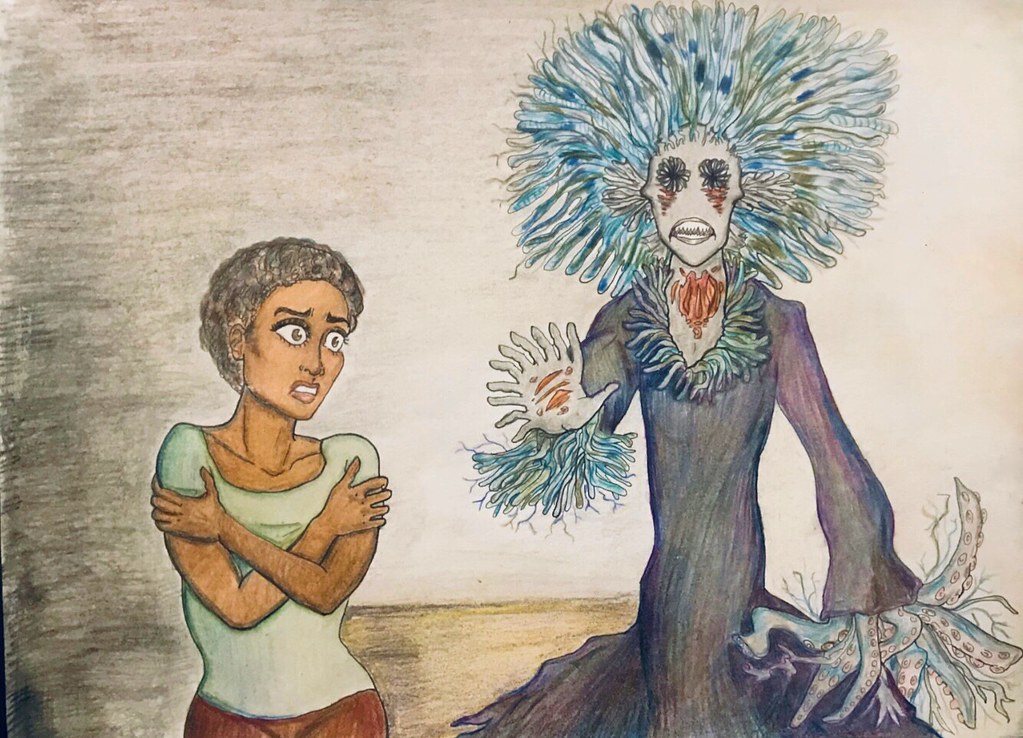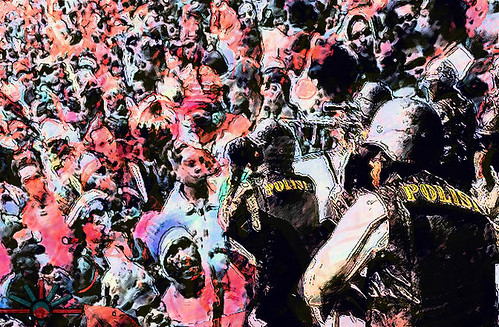Of the many dimensions of racial capital that have underlined the ways that urban living almost everywhere takes place, this brief essay emphasizes how the localization of urbanized articulations is consolidated in place and foreclosed of definitive emplacement through racial capital and the political technologies organized through blackness. In other words, if capital’s operations have depended upon extracting value from the specific characteristics of a locale and, as the relative value of that locale declines, upon identifying other locales with different yet related characteristics from which value might be extracted, blackness has functioned as a critical medium through which this process takes place. For blackness operates as the model and means through which value can be continuously converted, dispersed, and relocalized.
But just as blackness is mobilized as a means of extending capitalist operations, blackness itself is extended as a means of articulating persons and places that otherwise may be forced apart. It renders them part of something yet to be completely figured out. As blackness has wavered historically in its use between being “nothing” and “everything”, this sense of extension, of blackness extending itself to others, of being a means of extending the capacities, care, and concerns of people held in place or held up as objects of theft, figures something tremulous, provisional, and often contested. Such is witnessed in different parts of the world not commonly deemed “Black”—from the volatile mixtures of ethnic and nationalistic aspirations in Eastern Indonesia, as youth experiment with “blackness” as a way to find themselves to each other, to the ways in which youth across Northeast India attempt to find common cause across long histories of fragmentation. In Eastern Indonesia, where blackness has long been a means to dismiss and disqualify, as well as a means to alternately enforce wedges and links between West Papua and other East Indonesia provinces—to keep West Papua as essentially a settler colony—who is entitled to be Black and what blackness is allowed to mean become critical questions about how to make one’s life count in the larger world.
Beyond these considerations, there is the question of what holds the urban in place—its populations, sensibilities, labor, economic and symbolic coherence. Moving from the holds of ships transporting slave labor, the holds for the display and sale of Black bodies, the apparatuses of immobilization on plantations, the architectures of mines, and the geological codifications of earth processes (Yusoff 2020) all have underpinned the deployment of the fungibility of Black and Indigenous bodies. Here, Black existence is converted into signifiers of exchangeable value that knows no limit, that instrumentalizes the human being’s essential absence of defining characteristics and niches (Virno 2009) to become, through violence, a constantly refigured domain beyond what is instituted as the definitive human (Wynter 2003).

Holding On. Photo: eflon, CC BY 2.0.
This process haunts the capacity of the urban to hold anything together as a coherent entity. No matter the technologies of surveillance, the lures of citizenship, the curated affective inclinations, the provisions of services and welfare by states, the agglomeration of economic functions and their forward and backward linkages across space, the city is haunted by the violence necessary in order to ensure the scalability and consolidation of the plantation and mine as critical motors of urbanization. Holds are architectures simultaneously intersecting interdiction, boundedness, intimacy, and belonging. As such, the discursive politics and violence necessary to suture these things together operated through managing the intensive spatial proximities of masters, overseers, slaves, and the indentured. These proximities contained the over-coding of genealogical ties for some and their total abruption for others, the regimented temporalities of industrialized agricultural production and the seasonal cycles of the plot, and the total surveillance of socio-spatial organization and the dissimulative operations of Black spiritual practices.
Given these discordant trajectories, the violence of the holding takes place through the compelled exertions of bodies, not only through discipline and punishment, but in their amplified sexualization. It is this latter process that ramifies across the operations of consolidation, simultaneously epitomizing Black fungibility, constituting dangerous bodily exposures and transgressions “playing” with threats to the symbolic order, producing offspring whose lineage was refused patriarchal coding, and instituting an irreconcilable yet defining breach within the psycho-sexual composition of whiteness (JanMohamed 2011). While chattel slavery in its juridical sense may have limited application to thinking through the predominant forms of contemporary capture, if we think of it as beta, a continuously reformulated social calculus, the architectures of its antebellum applications introduced to today’s modernity are obdurate. These are architectures that upend the relationships of locality, proximity, intimacy, and touch. If commonly held notions of locality are associated with the capacity of persons to directly touch each other, be in touch, and view the implications of the sociality engendered by touch, enslavement and its sexual economies, as Hortense Spillers explains, rob the haptic of its power to bind, cohere, and cure in the use of touch as an invasion of coercive power. In the process, the body, as a juridical personality characterized by access to due process, is rendered flesh—repeatedly not only disfigured but extending outwards into inexplicable tremors of agency.
At the heart of the sociality of the urban is both the under-mining of the coherence of strata, households, and historical narrative and the underlining of the insufficiency of these contexts to hold. This is not only because of the threat of fugitivity but because affect and practice always had to be oriented elsewhere, extended across a wider terrain. These extensions were not simply the commodity circuits and the calculative instruments to which locales were articulated. But they were also extensions of orientation—i.e. a political order cemented through an abstracted whiteness held intact only through the elaboration of blackness as connoting both everything and nothing. For, blackness institutes the economization of comparative value and can travel anywhere with no specific definition. For Black people belonging was figured across an extended landscape of both human and non-human relations outside of territorial compartmentalization.
At the heart of the plantation, then, was the sense that everyone was always already gone, absent in the midst of the confusion of the brutal, the carnal, and the domestic. Even though the city may be indeed more than a mirror of the logics of the biopolitical order expressing the geological understandings of earth processes. Even though it may be more than a condensation or elaboration of the plantation and mine, with its crisscrossing heterogeneities, it remains in its simplest rendition the platform for the individuation of subjects and the exercise of their free will through property. Here, self, territory, and objects were to be held separate from others and coerced in the pursuit of continuous improvement and maximized value that foreclosed, through law and normative protocols of transaction, more transversal articulations across other kinds of relationality. Whereas some property could be designated as inalienable, it usually carried the connotation of being “stuck in time”, foreclosed to its own logics of potential temporal unfolding (Povinelli 2016).
Yet, the apparatuses that made Black and Indigenous bodies as property available to brutal coercion—the deferral of congealment and definitive individuation—is the potentiality of the difference without separation, in an availing of possibility with indeterminate outcome; what Hortense Spillers has called “empathy.” In other words, the apparatus of capture and coercion—necessary to bring property into development, into maximal value—produces extensionalities beyond the bordering of individuated property. This extends out into the world in tentative modes of agency that refuse to be a single being and thus prefigure differences without separability (Da Silva 2015).
Black liberation is thus not about bringing Black people as full participants into the normative urban system of accumulation and extraction but about creating conditions of urban inhabitation beyond the tropes of individual citizenship, freedom, and property.
This extensionality reveals the fictions of the heteronormative family, neighborhood solidarity, and corporate grouping as both the representative entities of city life and the nodes around which property is organized. As Ramon Amaro and Murad Khan (2020) emphasize, heteronormative family ties as the primary domestic unit underlining citizenship represent the fiction of fixed points, from which correlative relations are drawn proving the deductive truth of the relation—e.g. Black people lack morality. Therefore, they are unable to aspire to a proper judicial subject and family relation. As such, they can never be properly settled. But in this linear presupposition, the inverse is foreclosed, even if mathematically correct—i.e. the concept of proper judicial subjects and family relations produce immorality. The abruption of kinship within chattel slavery and its ramifications in the subsequent management of domestic units have continuously been instrumentalized as objects of policing and other judicial interventions in the calculated under-development of Black populations. At the same time, the expansive and astute resonances of Black social arrangements, based on extensionalities across different tropes of belonging, with the polyrhythmic character of city life, could propel the urban as a space of incessant experimentation, even as urban political institutions constantly revised the mechanisms for expelling Black people from viable endurances.

Extensions of belonging, photo entitled: The First Meeting of Lilith and Jdahya. Photo: sosulli2, CC PDM 1.0.
Given the conceptual foreclosure cited earlier, and faced with historical assertions of the entanglements of intimacy and violence, the very undoing of bodily integrity that otherwise finds its “reason” and authorization in proximate relations, a sense of locality must be operationalized elsewhere. Locality must be pieced together across distance and deformation, not in the form of conventionally instituted judicial bodies, but as something more dispersed and extended. This is something always potentially monstrous in that it entails materiality without ideal form. These extensions can be both toxic and virtuous, as the seepages and resonances across landscapes are themselves interdicted but also concentrated as particular attractors of both waste and resourcefulness, and in dispositions that are not always apparent.
At the same time, wherever we may be situated, we are presented with the demand to think of all that has transpired to enable the occupation of this position; all that gazes upon us in a refusal to stay silent or to capitulate to the mundane ordinariness of the violence entailed in securing the relative stability of such a position. This necessitates what Tina Campt (2019) refers to as the affective work of adjacency, i.e. the making of relations in spite of and because of the differences in experiences and power. Something which is not empathy for the other but an acknowledgement that there are no words or feelings sufficient to do the work of translation or put yourself into someone else’s shoes. Rather, confront and address the divergences, the extensiveness of unacknowledged suffering, and rework the possibilities of proximity.
Even in the most under-attended parts of the world, blackness continues to be mobilized as both the legitimation of extractive economies expropriating the material conditions of existence for populations referred to as “Black” and Indigenous for the purposes of both plunder and bringing necessary development to marginalized regions of multi-racial states and a platform to suture together new spaces of adjacency. In Eastern Indonesia, now considered a critical zone for green economy extraction, with its voluminous reserves of lithium, nickel, manganese, cobalt, and rare earth minerals, residents from Halmahera, West Papua, and Nusa Tengrara Timur are increasingly framed as “culturally” ensconced in primitive, barter economies, reflecting their “racial heritage.”As such, they are deemed asynchronous with the needs of the Indonesian nation, whose massive infrastructural inputs are now imposed as acts of benevolence capable of rendering them individual citizens. Localized resistance to these efforts is not only criminalized through expansive policing and militarization of resource use, but also treated as a refusal to exceed blackness.

Jayapura Protest, West Papua. Photo: AK Rockefeller, CC BY-SA 2.0.
On the other hand, youth, whose families are subject to dispossession and impoverishment, and who increasingly circulate through low-level jobs across the proliferation of mines and plantations is forging an important stratum of an emerging metropolitan territory encompassing often distant secondary cities and towns across Eastern Indonesia. An emerging sense of adjacency and urban locality accompanies the articulations operationalized in the management of expansive circuits of material inputs, infrastructure, minerals, and palm oil. For these youth, blackness is deployed as a heuristic to explore points of convergence among distinct ethnicities and geographical locations; a locus of both everyday antagonisms and prolific everyday collaborations and alliances that piece together a sense of locality across disparate terrain and backgrounds. Here, blackness responds to the disruption of local economies and cultures. This is a disruption waged under the auspices of blackness as that which is expendable and available for the exertion of arbitrary violence. But through repurposing blackness as a mode of experimentation, a new sense of metropolitan space is elaborated through the very bodily movements and initiatives of the youth themselves.
These oscillations of local erasure, dispersion, and the re-enactment of locality through the strange alliances and extensionalities vernacularized through blackness may simply reiterate, in parallel, the rhythms of capital to fix and unfix. But the extensionalities of blackness cannot be readily calculated; they do not necessarily compute and thus hold open the spaciousness of urban life as differences without separability.
AbdouMaliq Simone (Twitter) is Senior Professorial Fellow at the Urban Institute, University of Sheffield and Honorary Professor at the African Centre for Cities, University of Cape Town.
All essays on Racial Capitalism
Introduction: Racial Capitalism
Nik Theodore
The Stuff of Life: Frontier Infrastructures of Reproduction
Omar Jabary Salamanca
Racial Violence is Woven into the Fabric of our Cities
Libby Porter
The Cost of Platinum: Legacies of Violence and Subordination of Black Miners in South Africa’s Mining Towns
Asanda Benya
Policing, Racial Capitalism and the Ideological Struggle Over Public Safety
M.M. Ramírez
Blackness and Metropolitan Adjacency
AbdouMaliq Simone
Black Women on the Left of the Left in Brazilian Politics
Keisha-Khan Y. Perry & Edilza Sotero
Related IJURR articles on Racial Capitalism
Hamburg’s Spaces of Danger: Race, Violence and Memory in a Contemporary Global City
Key Macfarlane & Katharyne Mitchell
The Nomad, The Squatter and the State: Roma Racialization and Spatial Politics in Italy
Gaja Maestri
The Limits of Homeownership: Racial Capitalism, Black Wealth, and the Appreciation Gap in Atlanta
Scott N. Markley, Taylor J. Hafley, Coleman A. Allums, Steven R. Holloway & Hee Cheol Chung
Reappearance of the Public: Placemaking, Minoritization and Resistance in Detroit
Alesia Montgomery
Geographies of Algorithmic Violence: Redlining the Smart City
Sara Safransky
Sowing Seeds of Displacement: Gentrification and Food Justice in Oakland, CA
Alison Hope Alkon & Josh Cadji
‘Wilding’ in the West Village: Queer Space, Racism and Jane Jacobs Hagiography
Johan Andersson
‘Troubled Assets’: The Financial Emergency and Racialized Risk
Philip Ashton
Racialization and Rescaling: Post‐Katrina Rebuilding and the Louisiana Road Home Program
Kevin Fox Gotham
Race and the Production of Extreme Land Abandonment in the American Rust Belt
Jason Hackworth
Talkin’ ’bout the Ghetto: Popular Culture and Urban Imaginaries of Immobility
Rivke Jaffe
The Structural Origins of Territorial Stigma: Water and Racial Politics in Metropolitan Detroit, 1950s–2010s
Dana Kornberg
Controlling Mobility and Regulation in Urban Space: Muslim Pilgrims to Mecca in Colonial Bombay, 1880–1914
Nick Lombardo
Neoliberalism, Race and the Redefining of Urban Redevelopment
Christopher Mele
Reconfiguring Belonging in the Suburban US South: Diversity, ‘Merit’ and the Persistence of White Privilege
Caroline R. Nagel
Race Matters: The Materiality of Domopolitics in the Peripheries of Rome
Ana Ivasiuc
Fear and Loathing (of others): Race, Class and Contestation of Space in Washington, DC
Brandi Thompson Summers & Katheryn Howell
Everyday Roma Stigmatization: Racialized Urban Encounters, Collective Histories and Fragmented Habitus
Remus Creţan, Petr Kupka, Ryan Powell & Václav Walach
Disaster Colonialism: A Commentary on Disasters beyond Singular Events to Structural Violence
Danielle Zoe Rivera
The Aesthetics of Gentrification: Modern Art, Settler Colonialism, and Anti-Colonialism in Washington, DC
Johanna Bockman
Beyond the Enclave of Urban Theory
Austin Zeiderman
